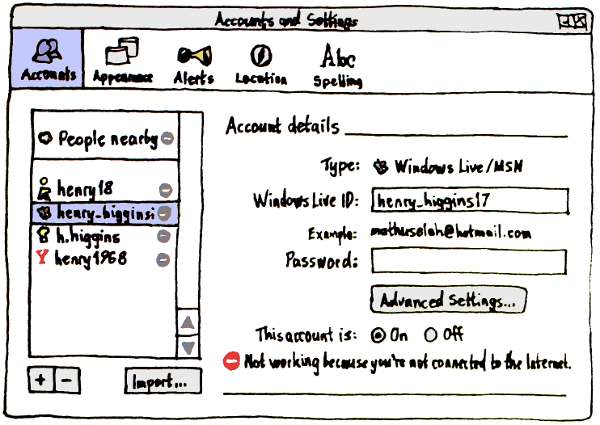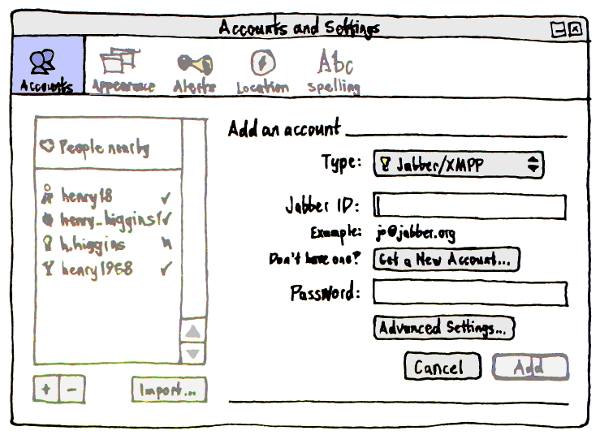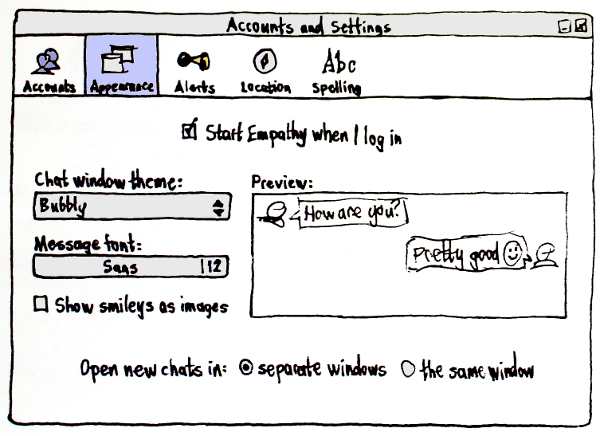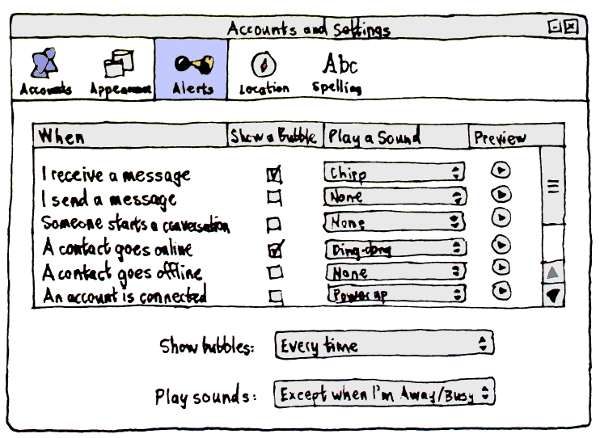Accounts and Settings window
The Accounts and Settings window should be accessed from an “Accounts and Settings…” menu item at the bottom of the “Edit” menu.
It should be a normal window, not a floating window or a dialog. Except when the “Add an account” pane is open, the window should close with the Ctrl+W keyboard combo.
Accounts pane
|
The On/Off radio buttons, and the account status text, should be aligned at the bottom of the pane regardless of the height of the other account settings, so that they are in the same position for account of different protocols.
The account ID examples should, where possible, use accounts already known to be examples rather than real accounts (e.g. free2rhyme for Yahoo).
Possible values for the status text:
- ✔ Online. (lined up under the “On” radio button)
- ❊ Connecting… (lined up under the “On” radio button)
- ✖ Not working because you are not connected to the Internet.
- ✖ Not working because the server is not responding. Try again later.
- ✖ Not working because your login details are incorrect.
The icons in the account list should be monochrome versions of those used for the status text.
|
When an account is being added, all controls in the window except for the (already-selected) “Accounts” tab and the account settings should be disabled.
The “Add” button should be disabled unless/until all the fields have been filled out in the expected syntax.
If focus leaves the “Screen Name”/“Windows Live ID”/etc field when it does not match the expected syntax, the “Example: <example>” caption should change to “Whoops: That’s not a complete ID” (or appropriate for the protocol), preceded by a mini error icon. When focus returns to the field, the caption should switch back to displaying the example.
The “Get a New Account…” button should open your default browser to the Web page for registering a new account with that protocol. (For Jabber/XMPP, this should be the “Public XMPP Services” page, or a friendlier equivalent once there is one.)
Appearance pane
|
The font setting for messages should be independent of the theme choice. Many people will just want to make the text of messages larger (or smaller) without having to choose a whole different theme.
Settings for the display of the contact list belong in its own View menu.
Alerts pane
|
For events where showing a bubble just isn’t appropriate, such as “I send a message”, there should not be a “Show a Bubble” checkbox. Whenever “Show a Bubble” is checked for “I receive a message”, it should be both checked and disabled for “Someone starts a conversation”.
Each “Play a Sound” menu should consist of the item “None”, then a separator, then a list of actual plausible sounds (using a human-friendly, capitalized and non-suffixed name for each), then a separator, then an “Other…” item for choosing a sound file from elsewhere. They should not refer to the Gnome Sound preferences, because it is unreasonable to require people to navigate to an entire separate window and scroll to find a differently-named item to configure the sound for the event they’re already looking at.
Whenever “Show a Bubble” is unchecked/unavailable and “Play a Sound” is set to “None” for an event, that event’s Preview button should be disabled.
For both the “Show bubbles” and “Play sounds” menus, the options should be “Every time”, “Except when I’m Away/Busy”, and “Never”. The “Show bubbles” menu should be enabled only when at least one event has “Show a Bubble” checked. And the “Play sounds” menu should be enabled only when at least one event has “Play a Sound” set to a value other than “None”.




